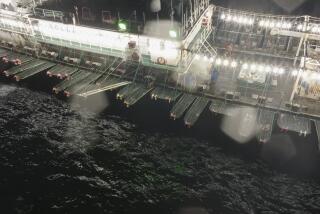Mission of Mercy Sails to Marshalls
- Share via
SAN PEDRO — An unusual maiden voyage will begin this morning when the 71-foot twin-hulled Canvasback, billed as one of the world’s largest catamarans, sets sail across the Pacific on a medical mission 6,000 miles away to the Marshall Islands, where aspirin--let alone penicillin--is rare.
A crew of eight will be headed by Jamie and Jacque Spence, who began building the boat five years ago and completed it in June. After arriving in the Marshalls in mid-January, the crew will be joined by six or seven volunteer physicians and dentists and two nurses--some of them husband-wife teams--who will fly over from the United States.
They will sail from island to island for six months, giving free medical and dental clinics and starting health-care training programs.
Jamie Spence described the Marshalls, which were a U.S. trust territory until becoming a republic in November, as a “desolate area where there are very few comforts, not even a nice place to eat, where it is difficult to keep your health and where communicable diseases are rampant.”
The islanders suffer from malnutrition, infant mortality is high, and medicine and trained medical personnel are scarce, according to the Project Canvasback office in Benecia, Calif., near San Francisco.
The Spences, who are in their 50s, said the project is the answer to questions they began asking themselves several years ago, about what they were supposed to be doing with their lives. At that time, they were making a living in the South Pacific transporting yachts and writing articles about sailing.
“Just by ourselves, out to sea, we became Christians,” Jacque Spence said. “Because of that conversion, our eyes opened to up to the needs of people around us. . . . We were not satisfied to make the islands our playground but wanted to get in, get back and help people.”
The Spences joined the Seventh-Day Adventist Church in Austraila. Many of those involved in the project are church members.
After returning to the United States, they put up $100,000 of their own money to start building the Canvasback, which cost about $500,000 to complete with the help of volunteer labor. “We built a hull so people would not just think we were dreaming, formed a nonprofit corporation, and solicited public donations,” she said.
Through a combination of money raised and donations of materials from companies and individuals, the Canvasback was completed and equipped as a floating clinic with a dental chair, portable dental unit complete with drills, portable X-ray machine and other medical apparatus.
The 36 Marshall Islands, with a population of 50,000, are part of Micronesia, an archipelago of 2,000 islands spread across an area larger than the United States, but whose land area could fit easily into Rhode Island.
Under an agreement with the new republic, the United States will continue to provide health services for 15 years. But Spence said the Marshall Islanders don’t have the political clout needed to get proper health care from the American government. “Who’s ever heard of them?” he asked. “They’re the most forgotten and isolated people in the world. There is no pressure on the government, no one lobbying for them, no one calling them to public attention.”
John Rasmussen, assistant Pacific regional health administrator for the U.S. Public Health Service, acknowledged that there are serious health problems in the isolated outer islands, which the government is attempting to solve.
Currently, he said, the Marshalls have nine doctors, five medical and dental officers who function as physicians and dentists, 27 registered nurses and two hospitals.
It will cost about $265,000 to operate the Canvasback for six months, which the project is raising through donations of supplies and money. There are plans to keep the boat in the Pacific six months a year, utilizing a pool of volunteer physicians and dentists.
The boat is departing at 10:30 a.m. this morning from Ports o’ Call Village in San Pedro, a place the Spences chose partly for news media exposure.
Jacque Spence said the Canvasback was named after a type of duck that migrates from north to south every year. “That is what we will do,” she said.
More to Read
Sign up for Essential California
The most important California stories and recommendations in your inbox every morning.
You may occasionally receive promotional content from the Los Angeles Times.












